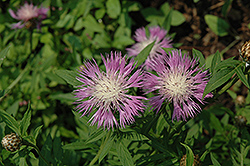It's all about ...
plants

Rosea Cornflower
Centaurea dealbata 'Rosea'
Height: 24 inches
Spread: 24 inches
Sunlight:
![]()
Hardiness Zone: 3a
Other Names: Persian Cornflower
Description:
Frilly, fringed rose-pink flowers appear from late spring to early summer, over mounds of cut green foliage; butterflies cannot resist these blooms; great for naturalizing or planting along borders
Ornamental Features
Rosea Cornflower features unusual rose lacecap flowers with white centers at the ends of the stems from late spring to early summer. The flowers are excellent for cutting. Its oval leaves remain green in colour throughout the season.
Landscape Attributes
Rosea Cornflower is an herbaceous perennial with an upright spreading habit of growth. Its medium texture blends into the garden, but can always be balanced by a couple of finer or coarser plants for an effective composition.
This plant will require occasional maintenance and upkeep, and is best cleaned up in early spring before it resumes active growth for the season. It is a good choice for attracting butterflies to your yard. Gardeners should be aware of the following characteristic(s) that may warrant special consideration;
- Self-Seeding
Rosea Cornflower is recommended for the following landscape applications;
- Mass Planting
- Border Edging
- General Garden Use
Planting & Growing
Rosea Cornflower will grow to be about 20 inches tall at maturity, with a spread of 24 inches. Its foliage tends to remain dense right to the ground, not requiring facer plants in front. It grows at a fast rate, and under ideal conditions can be expected to live for approximately 15 years. As an herbaceous perennial, this plant will usually die back to the crown each winter, and will regrow from the base each spring. Be careful not to disturb the crown in late winter when it may not be readily seen!
This plant should only be grown in full sunlight. It is very adaptable to both dry and moist locations, and should do just fine under typical garden conditions. It is considered to be drought-tolerant, and thus makes an ideal choice for a low-water garden or xeriscape application. It is not particular as to soil type or pH. It is highly tolerant of urban pollution and will even thrive in inner city environments. This is a selected variety of a species not originally from North America.
